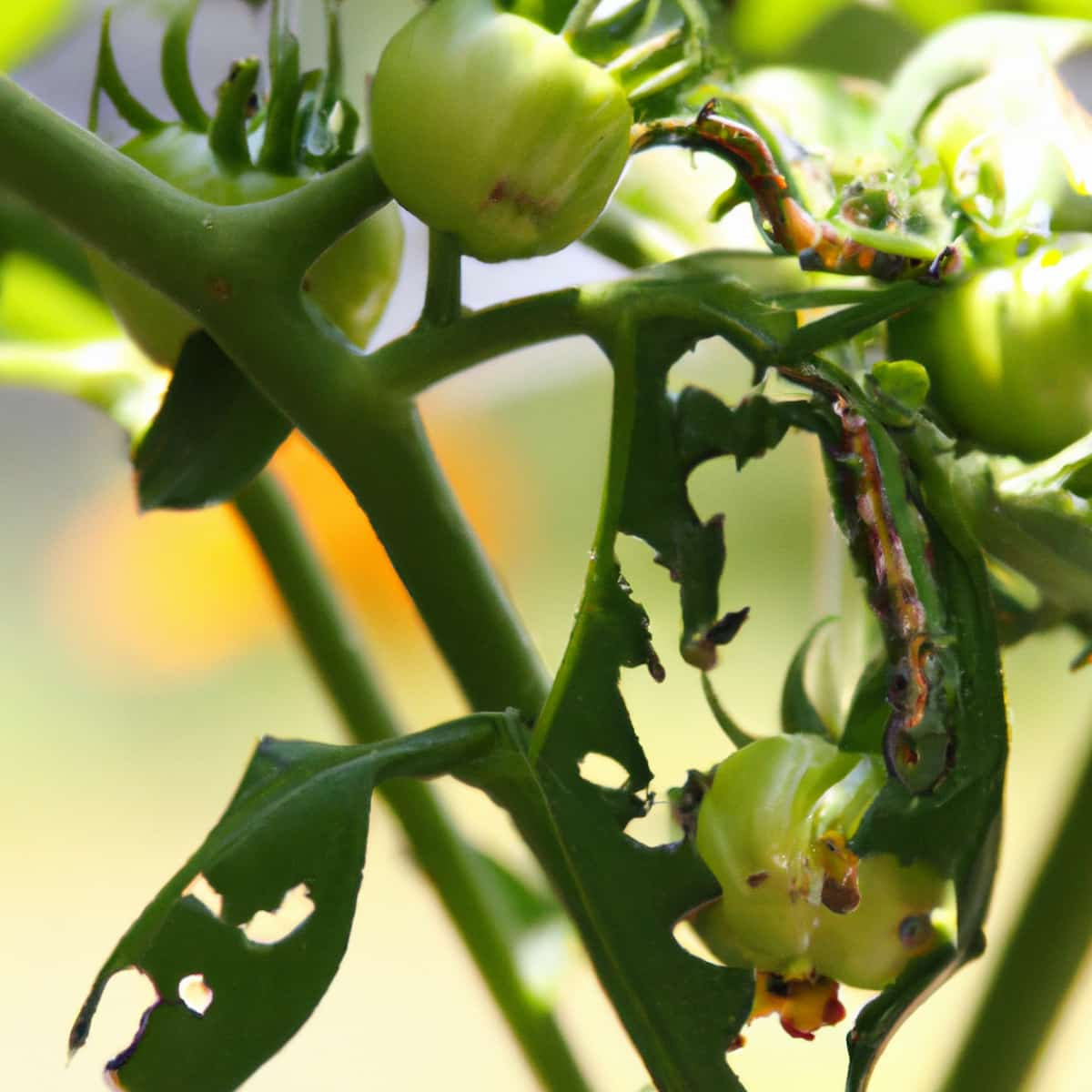The tobacco caterpillar (Spodoptera litura) is a pest of tomato crops that can cause significant damage to the leaves and fruit of the plant. It is a medium-sized moth that is active at night and lays its eggs in clusters on the leaves of the tomato plant. The caterpillars feed on the leaves and fruit of the plant, causing irregular holes and defoliation. This can result in reduced yields and lower-quality crops.

Tobacco Caterpillar management in Tomato
The life cycle of the Tobacco Caterpillar
- The tobacco caterpillar goes through four stages in its lifecycle: egg, larva, pupa, and adult.
- The female lays about 300 eggs in clusters that hatch in 3-5 days.
- The larva stage lasts 15-30 days, and the caterpillar measures 35-40 mm in length when fully grown.
- The pupa stage takes place in the soil and lasts 7-15 days.
- The adult stage is a moth that is active at night and lasts 7-10 days.
- The life cycle takes 32-60 days, with eight generations in a year.
Identification of Tobacco Caterpillar in Tomato field
These characteristics can be used to identify the tobacco caterpillar pest at each stage of its lifecycle:
- Egg: The egg masses of the tobacco caterpillar appear golden brown.
- Larva: The larva is pale greenish with dark markings and is gregarious in the early growth stage, later becoming solitary feeders.
- Pupa: The pupa is found in the soil and is brownish.
- Adult: The adult is a medium-sized and stout-bodied moth with pale grey to dark brown forewings and wavy white crisscross markings. The hind wings are whitish, with brown patches along the margin of the wing. The adult is active at night.
Damage symptoms of Tobacco Caterpillar in Tomato field
The tobacco caterpillar causes damage to plants by feeding on leaves, which results in the following:
- Early damage symptoms: In the early stages, the caterpillars feed in groups and scrape off the chlorophyll from the leaf lamina, causing it to take on a papery white appearance.
- Irregular holes on leaves: As the caterpillars grow and become voracious feeders, they create irregular holes in the leaves.
- Skeletonization: As the feeding continues, the leaves become skeletonized, leaving only the veins and petioles.
- Heavy defoliation: The heavy feeding of the caterpillar results in significant defoliation of the plant.
- Bored fruits: The caterpillar may also bore into fruits and cause irregular holes
In case you missed it: Whitefly Management in Tomato: Symptoms, Treatment, Chemical, Biological, Natural, and Organic Control

Tobacco Caterpillar management in Tomato by Cultural method
Cultural control of the tobacco caterpillar can include the following measures:
- Use of pheromone traps: Install traps baited with Spodolure, a pheromone, to monitor the presence of adult moths.
- Collection and destruction of egg masses and larvae: Regular scouting should be conducted to locate egg masses and leaf skeletons, which can then be mechanically removed and destroyed.
- Intercropping: Consider intercropping with non-host crops, which can be a barrier to the spread of the pest.
Tobacco Caterpillar management in Tomato by biological method
- Aqueous extracts of neem, chinaberry, Malabar nut, or Indian privet: Spray an aqueous extract of 200 g of leaves (soaked overnight) per litre of water.
- Tobacco decoction: Spray a decoction made from 250 g of tobacco, 30 g of liquid soap, and 4 litres of water boiled for 30 minutes and diluted 1:4 parts of water.
- Spodoptera NPV: Spray Spodoptera NPV (nuclear polyhedrosis virus) at a rate of 250 LE/ha, with 1% jaggery and a sticker (0.5 ml Beepol/litre) in the evening hours.
- Release of egg parasitoids: Release Trichogramma chilonis, an egg parasitoid, in the crop fields for six weeks at a rate of 50000 eggs per ha per week soon after the appearance of moths.
- Neem-based pesticides: Spray neem-based pesticides such as Margosom at a rate of 5 ml per litre of water.
- Poison baiting: Use poison baiting by spreading baits made from 10 kg of rice or wheat bran, 1 kg of jaggery, and 500 g of Dursban (chlorpyrifos) 3% G in furrows and repeating the baiting for 2-3 days.
Tobacco Caterpillar management in Tomato by chemical method
- Chemical pesticides or chemical methods for controlling the tobacco caterpillar include the application of malathion 50 EC.
- The recommended solution is a 0.05% solution of malathion 50 EC and should be applied at 7-day intervals if necessary.
In case you missed it: Fruitworm Management in Tomato: Symptoms, Treatment, Chemical, Biological, Natural, and Organic Control

Tobacco Caterpillar management in Tomato by organic/natural method
- Using jaggery and rice bran baits is one of the organic control methods for tobacco caterpillars in tomato crops. This method uses a combination of jaggery, rice bran, and emamectin benzoate to create a toxic bait for the caterpillars.
- The bait is spread on the nursery beds during the evening when the caterpillars are active. It is an effective way to control their populations without using chemical pesticides.
Preventive measures for control of Tobacco Caterpillar
- Use tolerant varieties if available
- Sow early to avoid insect population peaks
- Irrigate regularly to avoid drought
- Plant trap crops and repellent plants
- Remove weeds
- Provide bird perches
- Use light or pheromone traps
- Check for signs of the pest and destroy egg masses and larvae
- Handle plants carefully during cultivation
- Maintain tool and equipment hygiene
- Plow deep after harvest to expose pupae to natural enemies and weather factors
Conclusion
In conclusion, Integrated Pest Management (IPM) of tobacco caterpillars in tomato crops involves a combination of cultural, biological, natural, and chemical control methods. Biological control methods involve using aqueous neem extracts and other botanical insecticides, releasing egg parasitoids, and using Spodoptera NPV. Natural methods include using jaggery and rice bran baits and poison baiting.
As a last resort, chemical control methods include using chemical pesticides such as malathion. IPM ensures effective and sustainable pest management in tomato crops without relying solely on chemical control methods, reducing the risk of pesticide resistance. Following these guidelines, tomato growers can effectively manage the tobacco caterpillar and maintain healthy and productive crops.
- Natural Solutions for Pest Control in Flower Gardens
- Types of Fungicides Used in Agriculture
- Common Issues in the Fruit Development Stage of Pomegranate Farming
- Fruit Development Issues in Papaya: Easy Solutions and Treatment
- Soil-Borne Diseases and How to Protect Your Plants
- Practices to Prevent Disease Spread in the Garden
- From Wilted to Thriving: How to Treat Root Rot Naturally in Houseplants
- Natural Remedies to Cure Brown Spots on Fig Tree Leaves
- Natural Solutions for Poinsettia Problems: 100% Effective Remedies